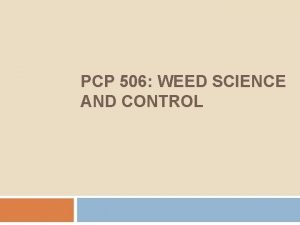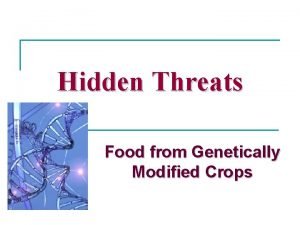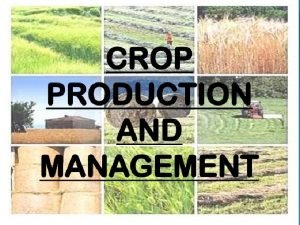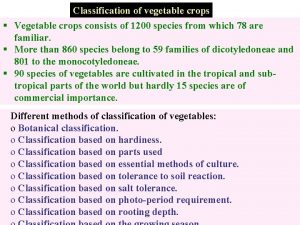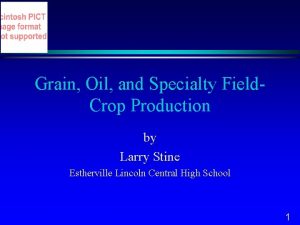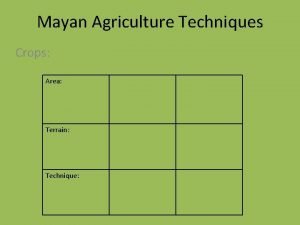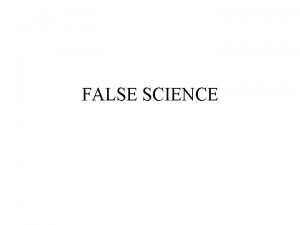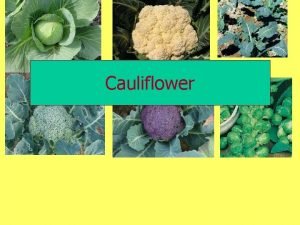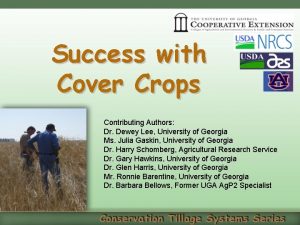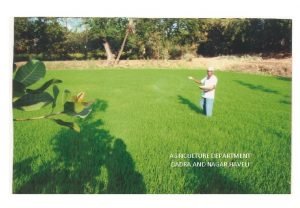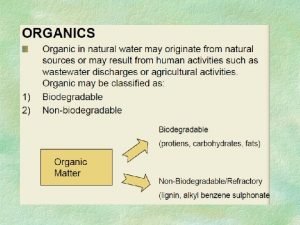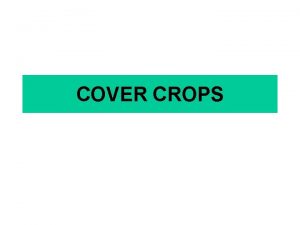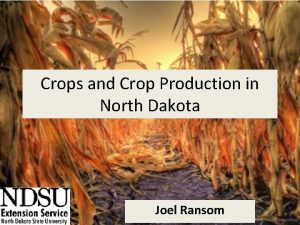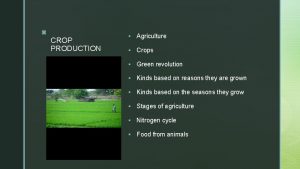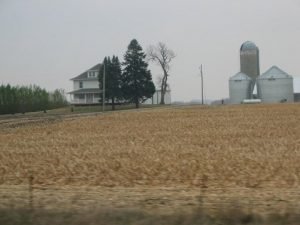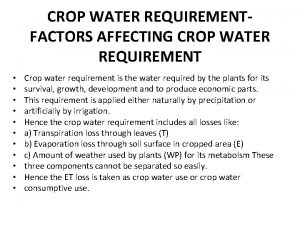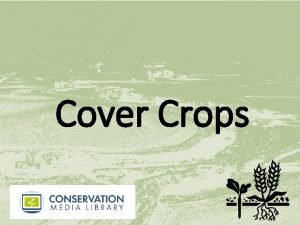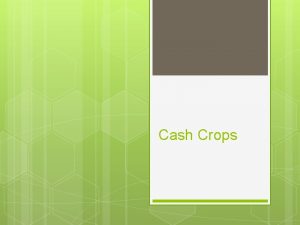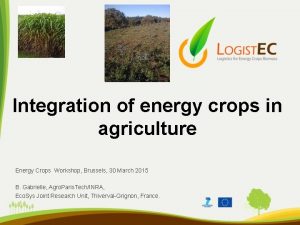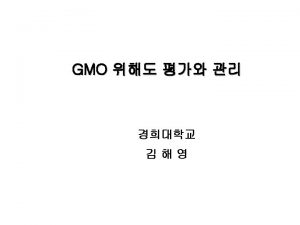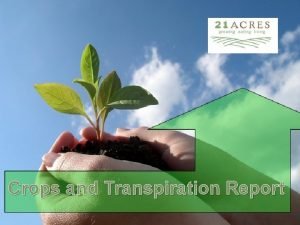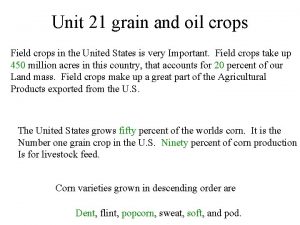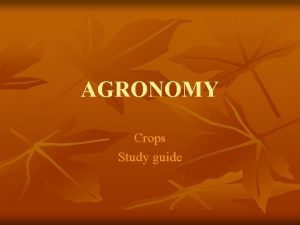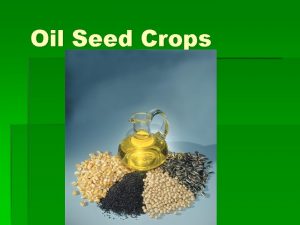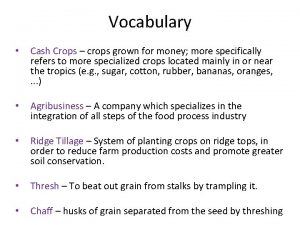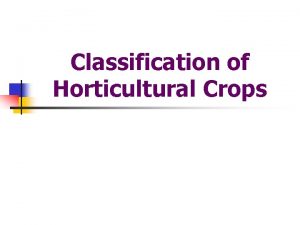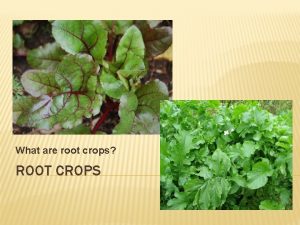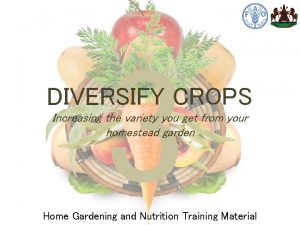IMPROVEMENT IN CROPS CROP VARIETY IMPROVEMENT CROP PRODUCTION

























- Slides: 25

IMPROVEMENT IN CROPS CROP VARIETY IMPROVEMENT CROP PRODUCTION IMPROVEMENT CROP PROTECTION MANAGEMENT ANIMAL HUSBANDRY POULTRY FARMING FISH PRODUCTION CATTLE FARMING PV. PRADEEP

INTERDUCTION It is everyone’s right to have the food for live. Day by day population is increasing and cultivating earth is decreasing. So it is very necessary to improve the food resources.

There are many community in the world which are living in starvation of the food. Every year millions of people dieing due to hunger. We do not have any major scope for increasing the area of land under cultivation. Therefore, it is necessary to increase our production efficiency for both crops and livestock. Livestock also is a source of food. Milk production, meat, eggs, etc. also need to be improved.

IMPROVEMENT IN CROPS Improvement in crops can be done by good choice of seeds for planting. Second is the nurturing of the crop plants. The third is the protection of growing and harvested crops. Thus, the major groups of activities for improving crop yields can be classified as: Ø Crop variety improvement Ø Crop production improvement Ø Crop protection management.

CROP VARIETY IMPROVEMENT farmer would need to be provided with good quality of seeds. Variety can be improved by hybridization. Hybridization refers to crossing between genetically dissimilar plants.

Some of the factors for which variety improvement is done are: Ø Higher yield: To increase the productivity of the crop per acer. Ø Improved quality: Quality consideration of the crop products vary from crop to crop. Ø Biotic and abiotic resistance: Crop production can go down due to biotic and abiotic stresses under different situation. Ø Change in maturity duration: The shorter the duration of the crop from sowing to harvesting, the more economical is the variety. Ø Desirable agronomics characteristics: Tallness and profuse branching are desirable characters for fodder crops.

Ø Wider adaptability: Developing variety for wider adaptability will help in stabilizing the crop production under different environmental conditions.

CROP PRODUCTION MANAGEMENT Just as we need food for development, growth and wellbeing, plants also require nutrients for growth. (i) Nutrient management Nutrients are supplied to plants by air, water and soil. There are 16 nutrients which are essential for plants. Air supplied carbon and oxygen, hydrogen comes from water, and soil supplies the other 13 nutrients to plants. Almost these 13 nutrients, 6 are required in large quantity and therefore called macro-nutrients. The other 7 nutrients are used by plants in small quantities and are therefore called micro-nutrients.

TABLE: Nutrients supplied by air, water and soil SOURCES NUTRIENTS Air carbon, oxygen Water Hydrogen, oxygen Soil (i) (ii) Macronutrients: nitrogen, sulphur, phosphorus, calcium, magnesium. Micronutrients: iron, zinc, boron, copper, chlorine, manganese. To increase the yield, the soil can be enriched by supplying these nutrients in the form manure and fertilizers.

MANURE Manure contains large quantities of organic matter. Manure is prepared by the decomposition of animal excreta and plant waste. This involves increasing the water holding capacity in the sandy soil. Using biological waste material is also away of recycling the farm waste. Based on the kind of the biological material used, manure can be classified as: (i) Compost and vermi-compost: The process in which the farm waste like livestock. , vegetable waste, sewage waste, etc. is decomposed in the pits is known as composting. The compost is rich in organic matters and nutrients. Compost is also prepared by using earthworms to hasten the process of decomposition of plants and animal refuse. This is known as vermi-compost.

(ii) Green manure: Prior to the sowing of crop seed, some plants like sun hemp or guar are grown and then mulched by ploughing them into the soil. These green plants thus turns into green manure which helps in enriching the soil in nitrogen and phosphorous.

FERTILISERS Fertilizers are commercially produced plant nutrients. Fertilizers supplies nitrogen, phosphorus and potassium. They are used to ensure good vegetative growth. Fertilizers should be applied carefully in the term of proper dose, time , and observing pre- and postapplications for their complete utilization.

(ii) Irrigation Ø Ø Ø Most parts of India depends on rain for irrigation for their crops. But other measures also being adopted by farmers. Several different kinds of irrigation system are: Wells: There are two types of wells, namely dug wells and tube wells. In a dug well water is collected from water bearing strata. Tube wells can tap the water from deeper strata. From these wells, water is lifted by pumps for irrigation. River lift systems: In this system water is directly drawn from the rivers for supplementing irrigation in area close to rivers. Tanks: These are small storage reservoirs, which intercept and store the run-off of smaller catchment areas.

Ø Canals: this is usually elaborate and extensive irrigation system. In this system canals receive the water from one or more reservoirs or from the rivers. The main canal is divided into branch canals having further distributaries to irrigated field.

(iii) Cropping Patterns Ø Ø Mixed cropping: Mixed cropping is growing two or more crops simultaneously on the same piece of land, for example, wheat + gram or cabbage + any other vegetable. This reduces risk and gives some insurance against failure of one of the crops. Inter-cropping: Inter- cropping is growing two or more crops simultaneously on the same field in definite pattern. The crops are selected such that their nutrient requirements are different. MIXED CROPPING--

Crop Rotation: The growing of different crops on a one piece of land in a pre-planned succession is known as crop rotation. INTER-CROPPING CROP ROTATION Ø

CROP PROTECTION MANAGEMENT Field crops are infested by a large number of weeds, insect pest and diseases. If weeds and pests are not controlled at the appropriate time then they can be damage the crops so much that most of the crop is lost. Weeds, insects and diseases can be controlled by various methods. One of the most commonly used method is the use of pesticides. Weeds control methods also includes mechanical removal.

STORAGE OF GRAINS Storage losses in agriculture producer can be very high. Factors responsible for such losses are biotic- insects, rodents, fungi, mites and bacteria and abioticinappropriate moisture and temperatures in the place of storage. preventive and control measures are used before grains are stored for future use.

ANIMAL HUSBANDRY Animal-based farming includes cattles, goats, sheep, poultry and fish farming. As the population increase and as living standard increase, the demand for the milk, eggs and meat is also going up. Also, growing awareness of the need for humane treatment of livestock has brought in new limitation in livestock farming. Thus, livestock production also needs to be improved.

CATTLE FARMING Cattle husbandry is done for two purposes- milk and draught labour for agricultural work such as tilling, irrigation and carting. Milk production depends, to some extent, on the duration of lactation period, meaning the period of milk production after the birth of a calf. So, milk production can be increased by increasing lactation period.

POULTRY FARMING Ø Ø Ø Poultry farming is undertaken to raise domestic fowl for egg production and chicken meat. Therefore, improved poultry breeds are developed and farmed to produce layers for eggs and broilers for meat. The cross- breeding programmes between India and foreign breeds for variety improvement are focused on to develop new variety for the following desirable traits. Number and quantity of chicks; Dwarf broiler parent for commercial chick production; Summer adaptation capacity/ tolerance to high temperature; Low maintenance requirements; Reduction in the size of the egg-laying bird with ability to utilize more fibrous cheaper diets formulated using agricultural by-products

EGG AND BROILER PRODUCTION Broiler chickens are fed with vitamin-rich supplementary feed for good growth rate and better feed efficiency. Care is taken it avoid mortality and to maintain feathering and carcass quantity. They are produced as broilers and sent to market for meat purposes.

FISH PRODUCTION Fish is a cheap source of animal proteins for our food. Fish production includes the finned true fish as well as shellfish such as prawns and molluscs. There are two ways of obtaining fish. One is from natural resources, which is called capture fishing. The other way is by fish farming, which is called culture fishery.


 Diagram alir proses produksi
Diagram alir proses produksi Crop improvement in biotechnology
Crop improvement in biotechnology Illinois crop improvement
Illinois crop improvement Allelospoly
Allelospoly Genetically modified crops have
Genetically modified crops have Pictures of food crops
Pictures of food crops Warm season crops
Warm season crops Subsistence sinew
Subsistence sinew North central plains
North central plains Ergot of bajra
Ergot of bajra Catch crops examples
Catch crops examples 5 classification of vegetables
5 classification of vegetables Farmer plants different crops in a field each year
Farmer plants different crops in a field each year Golden crops foe
Golden crops foe Kayla slater
Kayla slater The primary harvesting machine used for field crops is the:
The primary harvesting machine used for field crops is the: Scientific name for root vegetables
Scientific name for root vegetables The jumano built villages and grew crops near the
The jumano built villages and grew crops near the Mayans agriculture techniques
Mayans agriculture techniques Genetically modified crops have
Genetically modified crops have Golden crops foe
Golden crops foe Preventive of curds from direct sunlight is known as
Preventive of curds from direct sunlight is known as Dewey pest control
Dewey pest control He never polishes his shoes so he never looks smart
He never polishes his shoes so he never looks smart Agriculture projects in dadra & nagar haveli
Agriculture projects in dadra & nagar haveli Crops
Crops



